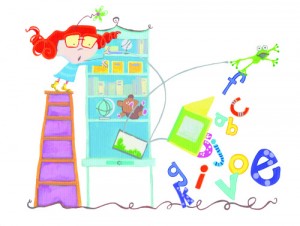February 25, 2013
Eloise Wilkin's The New Baby (or, "The Blog Post That Cost Me $50")
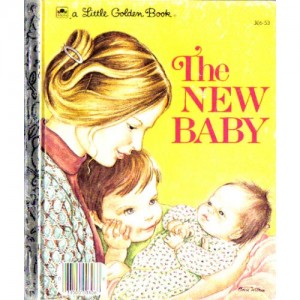 In November of 1981, my sister was born, when I was 2. The month before, according to to the note my mom made on the inside cover, I received from family friends a copy of The New Baby by Ruth and Harold Shane, illustrated by Eloise Wilkin. The New Baby became quite famous in our family as I memorized it entirely, and I’d amaze guests with my precocious “reading” skills. I have quite a vivid recollection of engaging with this book when I was very small, and when I read it now with Harriet, it’s not surprising that I loved it.
In November of 1981, my sister was born, when I was 2. The month before, according to to the note my mom made on the inside cover, I received from family friends a copy of The New Baby by Ruth and Harold Shane, illustrated by Eloise Wilkin. The New Baby became quite famous in our family as I memorized it entirely, and I’d amaze guests with my precocious “reading” skills. I have quite a vivid recollection of engaging with this book when I was very small, and when I read it now with Harriet, it’s not surprising that I loved it.
It’s something about Eloise Wilkin’s illustrations, I think. One of my other favourite childhood books was We Help Mommy, written by Jean Cushman, whose pictures still intrigue me now as much as they did 30 years ago. They intrigue Harriet too. It’s funny, because the illustrations were dated when I was small, and by now they’re probably about 70 years off, but it doesn’t make them any less engaging. Perhaps even more so? Because time has made these simple domestic tales become full of tiny mysteries (ie why do they clean the floor with a dust mop and not a vacuum?). These stories also show how the most essential parts of childhood never change.
 Anyway, I wanted to write about The New Baby, which my mom saved for many years and passed along to Harriet not long ago. Harriet is now absolutely obsessed with it too as we await the arrival of our own new baby a few months down the road. I like the book too, but the pictures fascinate me for different reasons, the uber-’70s fashions in particular. Check out the kitchen, with the cookbooks and lentils in jars up on the shelf, and whatever they’re eating out of a tagine. The copper pots! Mom’s billowy dress. On other pages, we encounter dad’s indescribably nasty suit (yellow with a blue and red print) and Aunt Pat’s brilliant red plaid pants and pink collegiate sweater at the end of the book. It turns out some things do change, and thank goodness…
Anyway, I wanted to write about The New Baby, which my mom saved for many years and passed along to Harriet not long ago. Harriet is now absolutely obsessed with it too as we await the arrival of our own new baby a few months down the road. I like the book too, but the pictures fascinate me for different reasons, the uber-’70s fashions in particular. Check out the kitchen, with the cookbooks and lentils in jars up on the shelf, and whatever they’re eating out of a tagine. The copper pots! Mom’s billowy dress. On other pages, we encounter dad’s indescribably nasty suit (yellow with a blue and red print) and Aunt Pat’s brilliant red plaid pants and pink collegiate sweater at the end of the book. It turns out some things do change, and thank goodness…
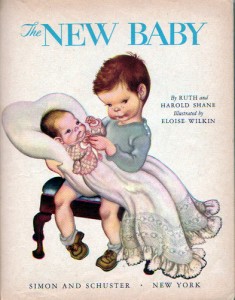 While I was googling to find images of the illustrations, however, I discovered that there was another version of The New Baby by Eloise Wilkin, and Ruth and Harold Shane. Turns out my book was a revised edition published in 1975, with updated illustrations. The original was published in 1948, and Wilkin’s drawings have a more-than-slightly-terrifying Norman Rockwell thing going on. Aunt Pat in this one is a hideous spinster with a crooked back, and in the kitchen there is not a lentil to be found. I was much intrigued by this, and really wanted to find out more about the original version of this book which was basically my literary foundation. It’s not in the library system but I tracked down a copy on AbeBooks, which should be coming my way in the next few weeks. I’m really looking forward to finding out the differences between the two.
While I was googling to find images of the illustrations, however, I discovered that there was another version of The New Baby by Eloise Wilkin, and Ruth and Harold Shane. Turns out my book was a revised edition published in 1975, with updated illustrations. The original was published in 1948, and Wilkin’s drawings have a more-than-slightly-terrifying Norman Rockwell thing going on. Aunt Pat in this one is a hideous spinster with a crooked back, and in the kitchen there is not a lentil to be found. I was much intrigued by this, and really wanted to find out more about the original version of this book which was basically my literary foundation. It’s not in the library system but I tracked down a copy on AbeBooks, which should be coming my way in the next few weeks. I’m really looking forward to finding out the differences between the two.
All this googling also directed me to the book Golden Legacy by Leonard Marcus, about the history of the Golden Books. (Apparently, I wrote about this book five years ago, though children’s books meant less to me then, which was probably why I never followed through so far as to actually read it.) As there is not a circulating copy of this book in the Toronto Public Library system, I was left with no choice but to order a copy for myself, which should arrive sometime this week. Very excited to encounter this one. Deirdre Baker’s 2008 review in the Toronto Star heightens my expectations.
Anyway, all this is how the quest to write this blog post ended up costing me 50 bucks. It’s going to lead to more blog posts though, and to new literary discoveries, and so I’m willing to bet that it all will be worth every penny in the end.
February 24, 2013
"Worse still, her parents were always bringing home MORE books."
The Girl Who Hated Books by Jo Meuris, National Film Board of Canada
Three years ago, I posted about this short film, but I’m returning to it again because this weekend I purchased the book upon which it is based for 50 cents from a bake sale/book sale taking place outside Harriet’s swimming lessons (along with a rice crispie square and two slices of cake). The book is The Girl Who Hated Books by Manjusha Pawagi and Leanne Franson, and we love it. I like the glimpses of storybook characters we know and love, but also how the family in the book is a little bit like our own, only far more eccentric:
“There were books in dressers and drawers and desks, in closets, cupboards and chests. There were books on the sofa and books on the stairs, books crammed in the fireplace and stacked on the chairs.
Worse still, her parents were always bringing home MORE books. They kept buying books and borrowing books and ordering books from catalogues. They read at breakfast and lunch and dinner…”
We’re not quite that bad, and while we do have books crammed in the fireplace, on the stairs, and even on our ceiling, we have not yet had to resort to the sink. And reading at dinner is strictly forbidden, though breakfast and lunch is all right, Saturday paper breakfast in particular. Obviously.
I like this book also because it’s a perfect addition to the excellent list we posted at 49thShelf last week, Picture Books Featuring Canadian Children of Colour, compiled by TPL librarian Joanne Schwartz.
February 11, 2013
Love Stories for Little Readers
When February comes around, even the littlest readers start thinking about love and cinnamon hearts. But of course, love itself is not all cupids and doilies, nor is it even store-bought Valentine cards distributed to every student in the class. Here is a great list of literary love stories that are ideally suited to a child’s perspective, demonstrating the amazing possibilities and benefits of love, friendship and family connections.
 Oscar’s Half-Birthday by Bob Graham: I adore this story of family life in the city, of two parents and a big sister who are so in love with their Baby Oscar that they can’t possibly wait all the way until his birthday to celebrate his baby goodness. And so on the occasion of Oscar’s half-birthday, they pack a picnic and trek up to the park. The celebration starts small, but by the time they’ve finished singing “Happy Birthday”, the chorus has been picked up by people all around them, and the world is alive with song, community and connection.
Oscar’s Half-Birthday by Bob Graham: I adore this story of family life in the city, of two parents and a big sister who are so in love with their Baby Oscar that they can’t possibly wait all the way until his birthday to celebrate his baby goodness. And so on the occasion of Oscar’s half-birthday, they pack a picnic and trek up to the park. The celebration starts small, but by the time they’ve finished singing “Happy Birthday”, the chorus has been picked up by people all around them, and the world is alive with song, community and connection.
 Without You by Geneviève Côté: Winner of the 2012 Marilyn Baillie Picture Book Award, Côté’s book is her second about two friends, Pig and Bunny, whose differences can sometimes come between them. In Without You, the friends have a falling out and decide that they don’t really need one another anyway. But everything from reading books to baking cookies turns out to be quite lonely without the other, and Pig and Bunny realize how much richer the world is when they are together. Love isn’t easy, but it’s worth it.
Without You by Geneviève Côté: Winner of the 2012 Marilyn Baillie Picture Book Award, Côté’s book is her second about two friends, Pig and Bunny, whose differences can sometimes come between them. In Without You, the friends have a falling out and decide that they don’t really need one another anyway. But everything from reading books to baking cookies turns out to be quite lonely without the other, and Pig and Bunny realize how much richer the world is when they are together. Love isn’t easy, but it’s worth it.
 Frog and Toad by Arnold Lobel: For easy-read texts, Arnold Lobel’s Frog and Toad books have remarkably depth. I continue to maintain that “The Letter” (from the Frog and Toad are Friends collection) is one of the best short stories I have ever read. The two friends face their fears and foibles together, and even their most mundane adventures result in humour, poignance, and surprises. I might declare that Frog and Toad are literature’s greatest companions (and it’s no surprise, really, that they were James Marshall’s inspiration for the als0-excellent George and Martha books).
Frog and Toad by Arnold Lobel: For easy-read texts, Arnold Lobel’s Frog and Toad books have remarkably depth. I continue to maintain that “The Letter” (from the Frog and Toad are Friends collection) is one of the best short stories I have ever read. The two friends face their fears and foibles together, and even their most mundane adventures result in humour, poignance, and surprises. I might declare that Frog and Toad are literature’s greatest companions (and it’s no surprise, really, that they were James Marshall’s inspiration for the als0-excellent George and Martha books).
 Should I Share My Ice-Cream? by Mo Willems: And speaking of literature’s great companions, you really can’t go wrong with any of Mo Willems’ Elephant and Piggie books. They’re simple, silly and definitely funny. In this one, Elephant Gerald is faced with a quandary: just how much is a friend required to give of himself (and his treats?). In the end, however, he realizes that the mathematics of friendship are really quite simple, and he is just lucky to be their beneficiary.
Should I Share My Ice-Cream? by Mo Willems: And speaking of literature’s great companions, you really can’t go wrong with any of Mo Willems’ Elephant and Piggie books. They’re simple, silly and definitely funny. In this one, Elephant Gerald is faced with a quandary: just how much is a friend required to give of himself (and his treats?). In the end, however, he realizes that the mathematics of friendship are really quite simple, and he is just lucky to be their beneficiary.
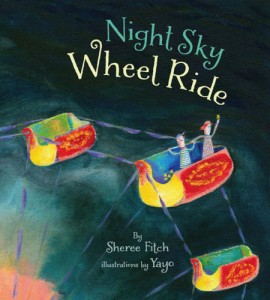 Night Sky Wheel Ride by Sheree Fitch, illustrated by Yayo: All of Sheree Fitch’s books are love stories, odes to language and to life itself. From this one, I love the line, “Can you hear the mermaids murmur/beluga whales sing/ feel the whirling stir/ of every little humming phosphorescent thing?” But this is also the story of a brother and a sister, about how much braver they can be when they’re together. And Night Sky Wheel Ride takes on a particular poignance when you learn about the real life story that inspired it.
Night Sky Wheel Ride by Sheree Fitch, illustrated by Yayo: All of Sheree Fitch’s books are love stories, odes to language and to life itself. From this one, I love the line, “Can you hear the mermaids murmur/beluga whales sing/ feel the whirling stir/ of every little humming phosphorescent thing?” But this is also the story of a brother and a sister, about how much braver they can be when they’re together. And Night Sky Wheel Ride takes on a particular poignance when you learn about the real life story that inspired it.
 Who Will Comfort Toffle? by Tove Janssen: We are crazy about the Moomins at our house, and are so pleased that two of Janssen’s picture books are newly in print and translated into English thanks to the good people at Drawn & Quarterly. In this one, Toffle the loner ventures out into the world, skirting its shadows and avoiding company as well as danger. It turns out that no Toffle is an island though–he finds a message in a bottle from a Miffle in need of his help. Being needed provides Toffle with the purpose he’s been seeking all along, as well as necessary companionship. I love the ending: “‘Forget the past and all your fears. Think of all the super fun/ That we can have. I’d love to see the beach, a shell, the sun…’/And Miffle knows and Toffle knows, that both have seen the end/ Of fear and fright and long, dark night, now each has found a friend.”
Who Will Comfort Toffle? by Tove Janssen: We are crazy about the Moomins at our house, and are so pleased that two of Janssen’s picture books are newly in print and translated into English thanks to the good people at Drawn & Quarterly. In this one, Toffle the loner ventures out into the world, skirting its shadows and avoiding company as well as danger. It turns out that no Toffle is an island though–he finds a message in a bottle from a Miffle in need of his help. Being needed provides Toffle with the purpose he’s been seeking all along, as well as necessary companionship. I love the ending: “‘Forget the past and all your fears. Think of all the super fun/ That we can have. I’d love to see the beach, a shell, the sun…’/And Miffle knows and Toffle knows, that both have seen the end/ Of fear and fright and long, dark night, now each has found a friend.”
 Lumpito and the Painter from Spain by Monica Kulling, illustrated by Dean Griffiths: I don’t know any kid who doesn’t love a story about a dog. This particular one is about a dachshund who goes to visit Pablo Picasso, and steals the painter’s heart. Lump has canine adventures with paper rabbits, a goat, and becomes immortalized in his new Master’s artworks.
Lumpito and the Painter from Spain by Monica Kulling, illustrated by Dean Griffiths: I don’t know any kid who doesn’t love a story about a dog. This particular one is about a dachshund who goes to visit Pablo Picasso, and steals the painter’s heart. Lump has canine adventures with paper rabbits, a goat, and becomes immortalized in his new Master’s artworks.
 The Owl and the Pussycat By Edward Lear, illustrated by Stéphane Jorisch: Lear’s curious and beautiful poem is reborn with Jorisch’s illustrations, which give readers a vivid picture of things like bong trees and runcible spoons. The unlikely pair is a cat from the wrong side of the tracks and the owl who loves her, both of them fleeing society’s disapproval via a pea-green boat (equipped with some honey and plenty of money). Read this book a few times and you’ll know the whole thing by heart: “And hand in hand by the edge of the sand, they danced by the light of the moon, the moon, the moon. They danced by the light of the moon.”
The Owl and the Pussycat By Edward Lear, illustrated by Stéphane Jorisch: Lear’s curious and beautiful poem is reborn with Jorisch’s illustrations, which give readers a vivid picture of things like bong trees and runcible spoons. The unlikely pair is a cat from the wrong side of the tracks and the owl who loves her, both of them fleeing society’s disapproval via a pea-green boat (equipped with some honey and plenty of money). Read this book a few times and you’ll know the whole thing by heart: “And hand in hand by the edge of the sand, they danced by the light of the moon, the moon, the moon. They danced by the light of the moon.”
January 30, 2013
On yarn, yarns and Extra Yarn
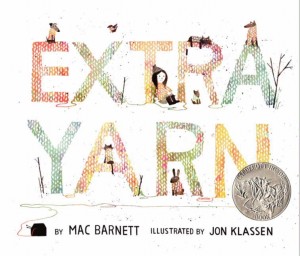 I’ve been knitting a baby blanket this last while, its colour yellow as selected by Harriet for whom yellowness is a sacred thing. And perhaps it was my current knitting project that got me thinking about the CanLit/Knitting Connection recently, about knitting in books and knitting about books. Then I thought about it more yesterday when we took out Extra Yarn by Mac Barnett and Jon Klassen from the library. What a spectacular book, about a little girl whose magical yarn stash never seems to run-0ut (and I know a lot of knitters, actually, with a similar affliction). I don’t know that Jon Klassen has ever gone wrong, and we loved this story with its splashes of colour, amusing prose, and sinister archduke (plus, SPOILERS, happy ending). Of course, you probably know all about this book already, especially since it was selected as a Caldecott Honour Book on Monday. Which was a particularly good day for Jon Klassen who also won the Caldecott Medal proper for the wonderful This is Not My Hat. I imagine this exciting news has changed Klassen’s whole life a little bit, but it’s changed mine too, because now I get to say that my website features an interview with a Caldecott winner.
I’ve been knitting a baby blanket this last while, its colour yellow as selected by Harriet for whom yellowness is a sacred thing. And perhaps it was my current knitting project that got me thinking about the CanLit/Knitting Connection recently, about knitting in books and knitting about books. Then I thought about it more yesterday when we took out Extra Yarn by Mac Barnett and Jon Klassen from the library. What a spectacular book, about a little girl whose magical yarn stash never seems to run-0ut (and I know a lot of knitters, actually, with a similar affliction). I don’t know that Jon Klassen has ever gone wrong, and we loved this story with its splashes of colour, amusing prose, and sinister archduke (plus, SPOILERS, happy ending). Of course, you probably know all about this book already, especially since it was selected as a Caldecott Honour Book on Monday. Which was a particularly good day for Jon Klassen who also won the Caldecott Medal proper for the wonderful This is Not My Hat. I imagine this exciting news has changed Klassen’s whole life a little bit, but it’s changed mine too, because now I get to say that my website features an interview with a Caldecott winner.
January 27, 2013
We visit the Intergalactic Travel Authority to meet Gabby
 We ventured westward today for our first visit to the Intergalactic Travel Authority, an out-of-this-world cafe at Bloor and Dufferin. The cafe was inspired by the 826 storefronts in America , which run literacy programs for young people. Apart from the usual coffee and baked goods, customers at the Intergalactic Travel Authority can also purchase black holes in cans, robots and monsters, plus BOOKS, the proceeds from which fund the cafe’s literacy programs.
We ventured westward today for our first visit to the Intergalactic Travel Authority, an out-of-this-world cafe at Bloor and Dufferin. The cafe was inspired by the 826 storefronts in America , which run literacy programs for young people. Apart from the usual coffee and baked goods, customers at the Intergalactic Travel Authority can also purchase black holes in cans, robots and monsters, plus BOOKS, the proceeds from which fund the cafe’s literacy programs.
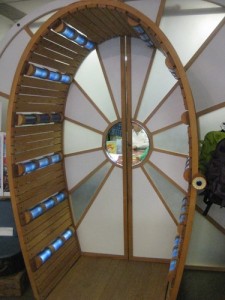 Which take place through the cafe’s magical spaceship doors…
Which take place through the cafe’s magical spaceship doors…
And we got to walk through those amazing sliding doors today because we were there for the launch of Joyce Grant‘s picture book Gabby, illustrated by Jan Dolby. (Joyce, a longtime literacy advocate, contributed a wonderful post to 49th Shelf this week for Family Literacy Day with tips for raising a reader.)
 Gabby is a fabulous book about a funny little girl who must deal with the consequences when she drops her book on the floor and all its letters fall out upon impact. When she starts picking up the letters now scattered all around her room, she is amazed to discover that the letters, when assembled in a precise manner, start taking on a life of their own. With the C, A and a T, Gabby makes a cat, but then it needs feeding, and trouble starts brewing when the next letters she picks up happen to spell “bird”.
Gabby is a fabulous book about a funny little girl who must deal with the consequences when she drops her book on the floor and all its letters fall out upon impact. When she starts picking up the letters now scattered all around her room, she is amazed to discover that the letters, when assembled in a precise manner, start taking on a life of their own. With the C, A and a T, Gabby makes a cat, but then it needs feeding, and trouble starts brewing when the next letters she picks up happen to spell “bird”.
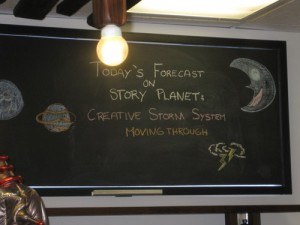 It’s a perfect book for Harriet, who is just beginning to understand how letters get together to make words. (Her partiality to the letter H, however, means that she’s not really bothered by the other 25 in the alphabet. Perhaps this book will help her get over that?) How letters with their individual sounds each have their own particular powers. Older readers will delight in guessing which words Gabby’s errant letters spell, as attested to by these kids’ reaction when Joyce was reading to us. The illustrations by Dolby are bright and fun, and subsequent readings reveal all kinds of hidden surprises.
It’s a perfect book for Harriet, who is just beginning to understand how letters get together to make words. (Her partiality to the letter H, however, means that she’s not really bothered by the other 25 in the alphabet. Perhaps this book will help her get over that?) How letters with their individual sounds each have their own particular powers. Older readers will delight in guessing which words Gabby’s errant letters spell, as attested to by these kids’ reaction when Joyce was reading to us. The illustrations by Dolby are bright and fun, and subsequent readings reveal all kinds of hidden surprises.
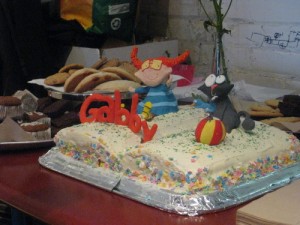 Though we in our family have a tendency to like any place where the cake is particularly abundant, we had an especially wonderful time today at the Gabby book launch. We were happy to pick up a copy of the book and have it signed by author and illustrator (who kindly noted with her autograph that H is indeed for Harriet!). And a book launch at such an extraordinary venue? It isn’t every day when you get the privilege of walking through a pair of sliding spaceship doors.
Though we in our family have a tendency to like any place where the cake is particularly abundant, we had an especially wonderful time today at the Gabby book launch. We were happy to pick up a copy of the book and have it signed by author and illustrator (who kindly noted with her autograph that H is indeed for Harriet!). And a book launch at such an extraordinary venue? It isn’t every day when you get the privilege of walking through a pair of sliding spaceship doors.
Isn’t reading wonderful?
January 16, 2013
On Elizabeth Mitchell, Blue Clouds, and storybook discovery…
 I discovered Elizabeth Mitchell a few months into Harriet’s life, and her music has been our family’s soundtrack ever since, the serenity of her voice making me a better mother and a happier person, her songs providing us all with a solid grounding in folk music, and their stories becoming the basis of so many of our own. And this year was a very good year to be an Elizabeth Mitchell fan–her album Little Seed came out in July and had the honour of not only being the soundtrack to our summer roadtrips (along with Carly Rae Jepsen), but was also nominated for a Grammy, and then Blue Clouds came out in October, and we managed to save it until Christmas, but we’ve been listening steadily ever since.
I discovered Elizabeth Mitchell a few months into Harriet’s life, and her music has been our family’s soundtrack ever since, the serenity of her voice making me a better mother and a happier person, her songs providing us all with a solid grounding in folk music, and their stories becoming the basis of so many of our own. And this year was a very good year to be an Elizabeth Mitchell fan–her album Little Seed came out in July and had the honour of not only being the soundtrack to our summer roadtrips (along with Carly Rae Jepsen), but was also nominated for a Grammy, and then Blue Clouds came out in October, and we managed to save it until Christmas, but we’ve been listening steadily ever since.
Blue Clouds is brilliant: a new version of “Froggie Went a Courtin'” that is Harriet’s favourite song on the album; my favourite track is her cover of Van Morrison’s “Everyone”; covers of David Bowie’s “Kooks”, Jimi Hendrix’ “May This Be Love”, Bill Withers’ “I Wish You Well”, “Blue Sky” by the Allman Brothers. We love new songs “Rollin’ Baby”, “Hop Up My Ladies”. And we love the song “Arm in Arm”, based on the verse by Remy Charlip: “Two octopuses got married and walked down the aisle, arm in arm in arm in arm in arm in arm in arm…”
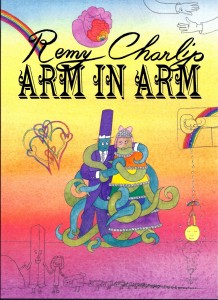 I’d never heard of Remy Charlip before Blue Clouds, but his artwork graces the album and its liner notes, and a letter inside by Brian Selznick introduces him further: “If you don’t own any of Remy’s books, you owe it to yourself to find as many as you can.” Which is the kind of guidance I’m always happy to take, and so we’ve been borrowing Remy Charlip books from the library like gangbusters over the last couple of weeks. And we didn’t quite know what to do with them at first: they weren’t stories to be read as much as books to be used, to be engaged with. It turned out that only the first line of the “Arm in Arm” song was Charlip’s, the line all the text on a single page, and the whole Arm in Arm book is made up of similar wordplay, riddles, play and whimsy. Harriet is in love with Mother Mother I Feel Sick Call For the Doctor Quick Quick Quick, and also the cowboy story Little Old Big Beard and Big Young Little Beard. We brought home Thirteen from the library yesterday, and it blew our minds! So many stories in a single book, a book you’ll read over and over and never the same way twice.
I’d never heard of Remy Charlip before Blue Clouds, but his artwork graces the album and its liner notes, and a letter inside by Brian Selznick introduces him further: “If you don’t own any of Remy’s books, you owe it to yourself to find as many as you can.” Which is the kind of guidance I’m always happy to take, and so we’ve been borrowing Remy Charlip books from the library like gangbusters over the last couple of weeks. And we didn’t quite know what to do with them at first: they weren’t stories to be read as much as books to be used, to be engaged with. It turned out that only the first line of the “Arm in Arm” song was Charlip’s, the line all the text on a single page, and the whole Arm in Arm book is made up of similar wordplay, riddles, play and whimsy. Harriet is in love with Mother Mother I Feel Sick Call For the Doctor Quick Quick Quick, and also the cowboy story Little Old Big Beard and Big Young Little Beard. We brought home Thirteen from the library yesterday, and it blew our minds! So many stories in a single book, a book you’ll read over and over and never the same way twice.
I absolutely love art that takes you somewhere, and artists who collaborate. Getting to know Remy Charlip via Elizabeth Mitchell has been like getting to know a friend, and so when I discovered tonight via internet search that he’d died in August, both Stuart and I were oddly saddened. His work is so much the definition of life that it seems impossible that his own could be over, but then the books live on, and how they do, over and over and never the same way twice.
January 10, 2013
Short fiction joy, news, and reviews.
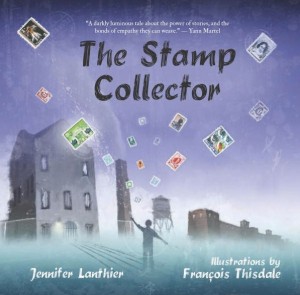 We received the most enormous pile of packages on Tuesday, including a magazine each for Harriet and I. Mine was Canadian Notes and Queries, featuring a new short story by Caroline Adderson, and Harriet’s was Chirp, with a fabulous short story by Sara O’Leary (!!), and I loved that both of us were experiencing the joy and goodness of short fiction in fine Canadian magazines, and that Harriet gets to appreciate this fine thing from the age of 3. What a lucky girl.
We received the most enormous pile of packages on Tuesday, including a magazine each for Harriet and I. Mine was Canadian Notes and Queries, featuring a new short story by Caroline Adderson, and Harriet’s was Chirp, with a fabulous short story by Sara O’Leary (!!), and I loved that both of us were experiencing the joy and goodness of short fiction in fine Canadian magazines, and that Harriet gets to appreciate this fine thing from the age of 3. What a lucky girl.
In other news, I was quoted in this excellent piece by Anne Chudobiak in the Montreal Gazette about the CWILA count and lack of female reviewers in Canadian journals and newspapers. And my review of The Stamp Collector by Jennifer Lanthier and Francois Thisdale is now up at Quill & Quire.
January 9, 2013
Time, Growth and Change: Books for the New Year
 This is my latest cross-post for Bunch Family!
This is my latest cross-post for Bunch Family!
We were reading Chicken Soup With Rice by Maurice Sendak on New Year’s Eve because, with all Sendak’s usual mischief and fun, I love how it gives the reader a sense of the span of the year, which is not an easy concept to grasp when one is three-years-old. The book is mostly nonsense, but with verse that has steeped into our family vernacular: where else would Harriet have learned about “old Bombay,” a place she references at least daily in her imaginary play; we’re all fond of exclaiming, “Whoopy once/whoopy twice!” at odd moments; and shouting, “I told you once/I told you twice/ all seasons of the year are nice!”, which is actually true, if you think about it. As a primer of all things monthly, the book is hardly scientific–your child will come away assured that September is indeed the period in which he’ll ride a crocodile down the chicken soupy Nile. But he’ll know what the months are called, which is something, and you will have enjoyed having read this jolly little book to him.
 With Chicken Soup and the New Year, I started thinking about other book about time, growth, and change, about the cyclical nature of a year and a life, and Paulette Bourgeois’ Big Sarah’s Little Boots came to mind, illustrated by Brenda Clark. It’s the story of a little girl who loves her rubber boots, which seem to deliver her extraordinary puddle-jumping powers. But one day when she puts her boots on, they no longer fit, and none of Sarah’s attempts to stretch them are successful. Reluctantly, but stoically, she comes to accept that she is growing up and that there is as much to be gained as is left behind with every step forward she takes.
With Chicken Soup and the New Year, I started thinking about other book about time, growth, and change, about the cyclical nature of a year and a life, and Paulette Bourgeois’ Big Sarah’s Little Boots came to mind, illustrated by Brenda Clark. It’s the story of a little girl who loves her rubber boots, which seem to deliver her extraordinary puddle-jumping powers. But one day when she puts her boots on, they no longer fit, and none of Sarah’s attempts to stretch them are successful. Reluctantly, but stoically, she comes to accept that she is growing up and that there is as much to be gained as is left behind with every step forward she takes.
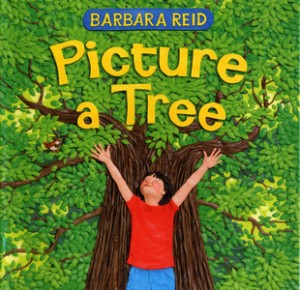 Barbara Reid’s Picture a Tree is always the book I pull out at bedtime when time has got away from us, not only because it’s short, but because it also manages to not remotely be lacking in depth. I am as nearly astounded at the overwhelming bounty of Reid’s creation as I am at nature’s– the fact that she has sculpted every single leaf in the book out of plasticine. And there are so many leaves, as Reid explores the various roles that trees play our life. My favourite spread shows trees as “A tunnel” (century-old branches stretching over a city street that looks like mine) “or an ocean” (a view of the city from a highrise balcony, the trees creating a sea of green). Reid moves through the seasons of the year, eloquently expressing the complicated idea that with every tree, “You may see the end of one thing, or the start of something new.”
Barbara Reid’s Picture a Tree is always the book I pull out at bedtime when time has got away from us, not only because it’s short, but because it also manages to not remotely be lacking in depth. I am as nearly astounded at the overwhelming bounty of Reid’s creation as I am at nature’s– the fact that she has sculpted every single leaf in the book out of plasticine. And there are so many leaves, as Reid explores the various roles that trees play our life. My favourite spread shows trees as “A tunnel” (century-old branches stretching over a city street that looks like mine) “or an ocean” (a view of the city from a highrise balcony, the trees creating a sea of green). Reid moves through the seasons of the year, eloquently expressing the complicated idea that with every tree, “You may see the end of one thing, or the start of something new.”
 Andrew Larsen shows something similar in his latest book, Bye Bye Butterflies, which is illustrated by Jacqueline Hudon-Verelli. On a grand scale, it’s the story of a boy beginning to grow up and make his way into the world, the experience encapsulated in a class project at his school in which caterpillars are raised into butterflies. “Our friends will be with us for just a few days…” the teacher tells the students. When the butterflies are grown and ready to be released, the story tells us, “The children felt a little happy and a little sad all at once.” With great sympathy and nuance, Andrew Larsen is demonstrating that these are the mixed emotions that a full life comprises.
Andrew Larsen shows something similar in his latest book, Bye Bye Butterflies, which is illustrated by Jacqueline Hudon-Verelli. On a grand scale, it’s the story of a boy beginning to grow up and make his way into the world, the experience encapsulated in a class project at his school in which caterpillars are raised into butterflies. “Our friends will be with us for just a few days…” the teacher tells the students. When the butterflies are grown and ready to be released, the story tells us, “The children felt a little happy and a little sad all at once.” With great sympathy and nuance, Andrew Larsen is demonstrating that these are the mixed emotions that a full life comprises.
 Some of my favourite books to read with my daughter are those that I remember reading as a child, the very books that belonged to me, an experience that connects me to my own history, to the reader and child I used be. This connection is made quite literal in Sara O’Leary’s When I Was Small, illustrated by Julie Morstad. It’s the third book by the duo, about a small boy called Henry whose mother and father view parenthood as an imaginative springboard (and really, isn’t it though?). In this book, Henry wants to hear stories about when his mother was small, and she indulges him with tales of when she so small she went swimming in the birdbath, could feast on a single raspberry, slept in a mittten and used a thimble to build sandcastles. Conventional concepts of space, time and generation are collapsed as she tells her son that when she was small, what she longed for most was a small boy of her own. She wanted a small boy to tell stories to, she explains, “because in stories we can be small together.”
Some of my favourite books to read with my daughter are those that I remember reading as a child, the very books that belonged to me, an experience that connects me to my own history, to the reader and child I used be. This connection is made quite literal in Sara O’Leary’s When I Was Small, illustrated by Julie Morstad. It’s the third book by the duo, about a small boy called Henry whose mother and father view parenthood as an imaginative springboard (and really, isn’t it though?). In this book, Henry wants to hear stories about when his mother was small, and she indulges him with tales of when she so small she went swimming in the birdbath, could feast on a single raspberry, slept in a mittten and used a thimble to build sandcastles. Conventional concepts of space, time and generation are collapsed as she tells her son that when she was small, what she longed for most was a small boy of her own. She wanted a small boy to tell stories to, she explains, “because in stories we can be small together.”
 Barbara Cooney’s Miss Rumphius is one of those books I loved when I was small, a book I’ve had kicking around my shelves since long before I had anybody small to call my own. In Miss Rumphius, Cooney evocatively illustrates the span of a lifetime, and also of history, art, literature and geography, and she shows the rich possibilities for what a single life can hold. Most importantly, the kernal of the story is as much a challenge as inspiration: “You must do something to make the world more beautiful.” The book ends on a note of possibility: ‘”All right,” I say. But I do not know yet what that can be.’
Barbara Cooney’s Miss Rumphius is one of those books I loved when I was small, a book I’ve had kicking around my shelves since long before I had anybody small to call my own. In Miss Rumphius, Cooney evocatively illustrates the span of a lifetime, and also of history, art, literature and geography, and she shows the rich possibilities for what a single life can hold. Most importantly, the kernal of the story is as much a challenge as inspiration: “You must do something to make the world more beautiful.” The book ends on a note of possibility: ‘”All right,” I say. But I do not know yet what that can be.’
 I love picture books that show the passage of time, the largeness of history and our relative smallness (but our place nonetheless) in the scheme. And of course, I also love house books, so Emma and Paul Rogers’ Our House, which is illustrated by Priscilla Lamont, was inevitably going to be a delight. The book is made up of four pretty ordinary domestic stories taking place in 1780, 1840, 1910, and 1990, each showing subtle changes in the house and surrounding area, and also the lifestyles of its changing inhabitants. The final story shows an awareness of the people who’d lived in the house before, as the family, whilst searching for an errant pet mouse, finds bits of history under floorboards and in backs of cupboards. (“We shed as we pick up, like travellers who must carry everything in their arms, and what we let fall will be picked up by those left behind.”– Tom Stoppard, Arcadia.) There is no supernatural element at work here, but the connection between the child in the first story and the child at the end reminded me of my favourite time-out-of-time childhood novels like Tom’s Midnight Garden, Charlotte Sometimes, and A Handful of Time.
I love picture books that show the passage of time, the largeness of history and our relative smallness (but our place nonetheless) in the scheme. And of course, I also love house books, so Emma and Paul Rogers’ Our House, which is illustrated by Priscilla Lamont, was inevitably going to be a delight. The book is made up of four pretty ordinary domestic stories taking place in 1780, 1840, 1910, and 1990, each showing subtle changes in the house and surrounding area, and also the lifestyles of its changing inhabitants. The final story shows an awareness of the people who’d lived in the house before, as the family, whilst searching for an errant pet mouse, finds bits of history under floorboards and in backs of cupboards. (“We shed as we pick up, like travellers who must carry everything in their arms, and what we let fall will be picked up by those left behind.”– Tom Stoppard, Arcadia.) There is no supernatural element at work here, but the connection between the child in the first story and the child at the end reminded me of my favourite time-out-of-time childhood novels like Tom’s Midnight Garden, Charlotte Sometimes, and A Handful of Time.
 Life Story by Virginia Lee Burton is perhaps the most ambitious picture book project I have ever encountered, the history of the universe as beginning with the birth of the sun. With her usual attention to technical detail (Burton was the daughter of an artist and an engineer, and in all her books, it shows), Burton’s story moves through the ages, the development of the earth and the plants and animals that inhabit it. In terms of time and place, her story because more and more focussed until her final page and a direct address to her reader: “And now it is your Life Story and it is you who plays the leading role. The stage is set, the time is now, and the place is wherever you are. Each passing second is a new link in the endless chain of Time. The drama of Life is a continuous story–ever new, ever changing, and ever wondrous to behold.”
Life Story by Virginia Lee Burton is perhaps the most ambitious picture book project I have ever encountered, the history of the universe as beginning with the birth of the sun. With her usual attention to technical detail (Burton was the daughter of an artist and an engineer, and in all her books, it shows), Burton’s story moves through the ages, the development of the earth and the plants and animals that inhabit it. In terms of time and place, her story because more and more focussed until her final page and a direct address to her reader: “And now it is your Life Story and it is you who plays the leading role. The stage is set, the time is now, and the place is wherever you are. Each passing second is a new link in the endless chain of Time. The drama of Life is a continuous story–ever new, ever changing, and ever wondrous to behold.”
January 3, 2013
Our Favourite Kids' Books Lately
 Lumpito by Monica Kulling: The evening Lumpito arrived in our lives, Harriet wanted to read it over and over. She’s a sucker for dog books, and Lump became beloved right away. In vivid illustrations by Dean Griffiths, we discover how a little dachshund finds his way into the heart (and home!) of Pablo Picasso. Neither Picasso nor his art are really the focal point of book, but I love that through Lumpito, Picasso becomes a point of reference and part of Harriet’s world.
Lumpito by Monica Kulling: The evening Lumpito arrived in our lives, Harriet wanted to read it over and over. She’s a sucker for dog books, and Lump became beloved right away. In vivid illustrations by Dean Griffiths, we discover how a little dachshund finds his way into the heart (and home!) of Pablo Picasso. Neither Picasso nor his art are really the focal point of book, but I love that through Lumpito, Picasso becomes a point of reference and part of Harriet’s world.
 This is Not My Hat by Jon Klassen: I’m not telling you anything you don’t already know–Jon Klassen is amazing. We were so excited for his new book, which is beautiful and just as subtly sinister as I Want My Hat Back. Harriet loves it, and enjoys it every time she imagines she’s outsmarted the story again.
This is Not My Hat by Jon Klassen: I’m not telling you anything you don’t already know–Jon Klassen is amazing. We were so excited for his new book, which is beautiful and just as subtly sinister as I Want My Hat Back. Harriet loves it, and enjoys it every time she imagines she’s outsmarted the story again.
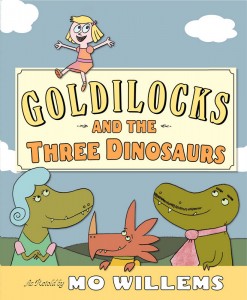 Goldilocks and the 3 Dinosaurs by Mo Willems: Once again, Willems is no undiscovered gem, but we love everything he does. And for our girl who is especially partial to dinos, we thought this one would be perfect. The book is geared for someone a bit older than three, and much of the humour is lost on Harriet, but we love it, and she gets off on the silliness. It’s the Three Bears turned inside out with a useful moral: if you find yourself in the wrong story, get out.
Goldilocks and the 3 Dinosaurs by Mo Willems: Once again, Willems is no undiscovered gem, but we love everything he does. And for our girl who is especially partial to dinos, we thought this one would be perfect. The book is geared for someone a bit older than three, and much of the humour is lost on Harriet, but we love it, and she gets off on the silliness. It’s the Three Bears turned inside out with a useful moral: if you find yourself in the wrong story, get out.
 A Good Trade by Alma Fullerton: In gorgeous illustrations by Karen Patkau, readers follow Kato, a small boy on his morning route to get water for his family in his small village in Uganda. We notice the vivid colours of his clothing and his friends’, the community spirit, and in the background are soldiers on guard, the fact that the children are shoeless. When an aid truck rolls into the village, Kato is intrigued by what’s inside, and imagines what he might give the aid worker in exchange.
A Good Trade by Alma Fullerton: In gorgeous illustrations by Karen Patkau, readers follow Kato, a small boy on his morning route to get water for his family in his small village in Uganda. We notice the vivid colours of his clothing and his friends’, the community spirit, and in the background are soldiers on guard, the fact that the children are shoeless. When an aid truck rolls into the village, Kato is intrigued by what’s inside, and imagines what he might give the aid worker in exchange.
 The Stone Hatchlings by Sarah Tsiang: We loved this one, a follow-up to Tsiang’s A Flock of Shoes. Abby is back, and she’s found two little eggs. They’re just stones, says her mother, but then we already know that Abby’s mother is often full of nonsense. In Abby’s vivid imagination (and with a great deal of care), the stones hatch into beautiful birds that become her companions. And when it’s time for the game to finally end, Abby’s ready when it does. (I interviewed Sarah Tsiang about the book last fall.)
The Stone Hatchlings by Sarah Tsiang: We loved this one, a follow-up to Tsiang’s A Flock of Shoes. Abby is back, and she’s found two little eggs. They’re just stones, says her mother, but then we already know that Abby’s mother is often full of nonsense. In Abby’s vivid imagination (and with a great deal of care), the stones hatch into beautiful birds that become her companions. And when it’s time for the game to finally end, Abby’s ready when it does. (I interviewed Sarah Tsiang about the book last fall.)
 LMNO Peas by Keith Baker: Not just another alphabet book (plus, it urges on Harriet when peas are on her plate. “Look,” I say. “They’re peas and they’re unique!”). This book is a triumph of design, written in jaunty verse and I love that this alphabet is astronauts, explorers, gigglers, investigators, outlaws, readers, voters vets and volunteers. Also that it has introduced, “Can you dig it?” into Harriet’s vernacular, and at one teaching point (“Kings”) features Elvis. We all love this one.
LMNO Peas by Keith Baker: Not just another alphabet book (plus, it urges on Harriet when peas are on her plate. “Look,” I say. “They’re peas and they’re unique!”). This book is a triumph of design, written in jaunty verse and I love that this alphabet is astronauts, explorers, gigglers, investigators, outlaws, readers, voters vets and volunteers. Also that it has introduced, “Can you dig it?” into Harriet’s vernacular, and at one teaching point (“Kings”) features Elvis. We all love this one.
 This Moose Belongs to Me by Oliver Jeffers: Jeffers is another underground kidlit sensation that only I have ever heard of or loved (ha). His new book is a bit of a departure visually, employing the collage technique he’s used in other books but this time using backdrops from old fashioned landscape paintings. It’s a funny little story about a boy who thinks he owns a moose, but the moose is most determined to own itself (and is partial to anyone giving away apples).
This Moose Belongs to Me by Oliver Jeffers: Jeffers is another underground kidlit sensation that only I have ever heard of or loved (ha). His new book is a bit of a departure visually, employing the collage technique he’s used in other books but this time using backdrops from old fashioned landscape paintings. It’s a funny little story about a boy who thinks he owns a moose, but the moose is most determined to own itself (and is partial to anyone giving away apples).
December 17, 2012
Christmas Reads: The Christmas Birthday Story by Margaret Laurence
 I hadn’t heard of The Christmas Birthday Story by Margaret Laurence until I read a collection of her letters A Very Large Soul in October. And I was intrigued by the sound of this book, “…a re-telling of the Nativity story, for use with small children. I wanted to tell it in such a way that small children would understand and be able to connect with it. I really wanted to emphasize the birth of the beloved child into a loving family.” For me, Christmas has always been about new life and family, and not any particular baby or family either, so I appreciated Laurence’s approach, particularly as she has religious knowledge to do it properly. Here is the Christmas story but without angels, God doesn’t get a mention. It’s a very human story of family, of travel, of a carpenter and his wife who are going to have a baby. The only thing otherwordly is that most peculiar star.
I hadn’t heard of The Christmas Birthday Story by Margaret Laurence until I read a collection of her letters A Very Large Soul in October. And I was intrigued by the sound of this book, “…a re-telling of the Nativity story, for use with small children. I wanted to tell it in such a way that small children would understand and be able to connect with it. I really wanted to emphasize the birth of the beloved child into a loving family.” For me, Christmas has always been about new life and family, and not any particular baby or family either, so I appreciated Laurence’s approach, particularly as she has religious knowledge to do it properly. Here is the Christmas story but without angels, God doesn’t get a mention. It’s a very human story of family, of travel, of a carpenter and his wife who are going to have a baby. The only thing otherwordly is that most peculiar star.
“That child Jesus grew up to be a man, and he was strong and hard-working, like Joseph the carpenter. He was gentle and kind, like Mary his mother. And he was something else, too. He was a wise teacher and a friend to all people./ So we remember him always, and at Christmas time we celebrate his birthday…”
Long out of print, copies are hard to come by online, but I am glad I tracked one down for us. It’s a beautiful story, ideal for those of us who are not religious but want our children to understand our culture, why we celebrate at this time of year. Helen Lucas’s illustrations are dated, but my child has been raised on vintage picture books and hasn’t noticed.
